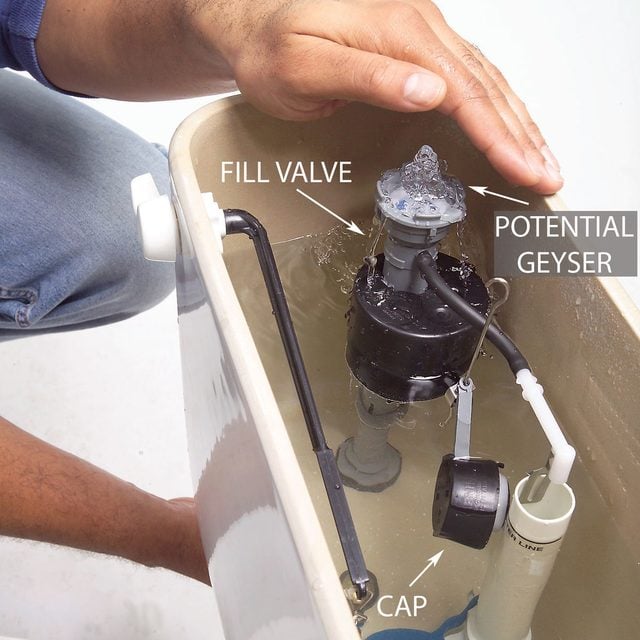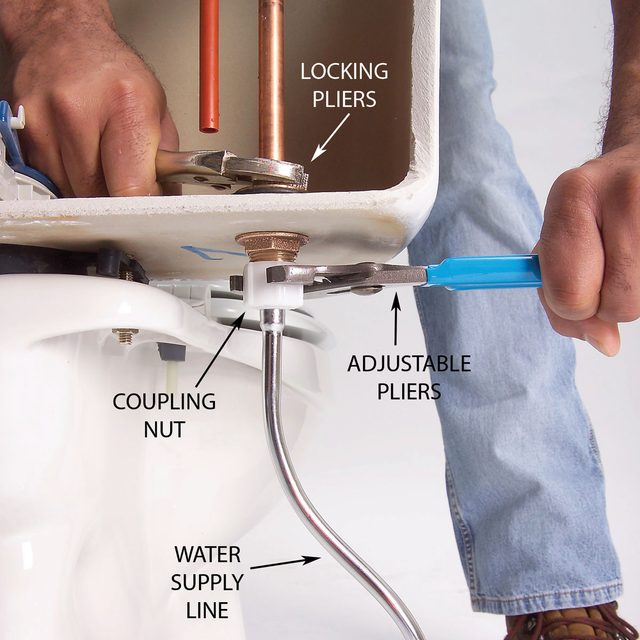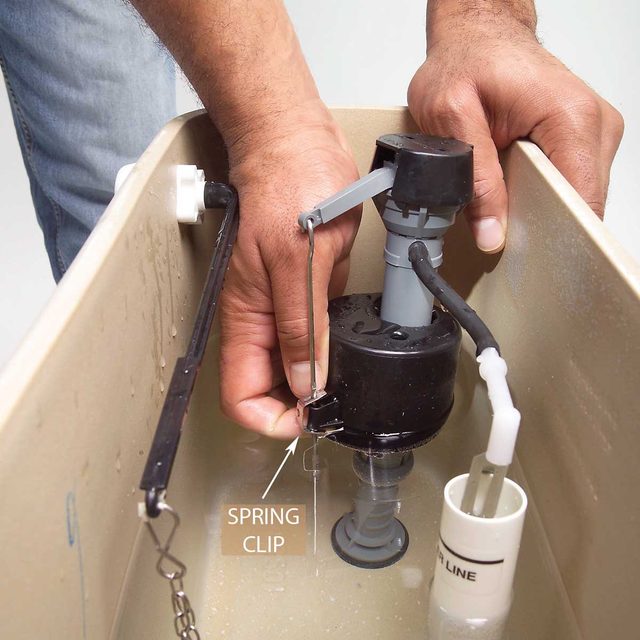Parts of a Toilet: What They Are and How to Fix
An hour or less
Beginner
Less than $20
Introduction
Toilets have moving parts, and moving parts wear out or break. If your toilet won't stop running, try repairing or replacing these key toilet parts. We cut away the fronts and backs of new toilets to show you how to replace these toilet tank parts. Your toilet and toilet tank parts won't look so pristine inside. You'll find scummy surfaces, water stains and corrosion. But don't be squeamish — the water is as clean as the stuff that comes out of your faucets.Tools Required
- 4-in-1 screwdriver
- Adjustable wrench
- Bucket
- Locking pliers
- Pliers
- Shop vacuum
- Tape measure
Materials Required
- Fill valve
- Flapper
- Toilet handle and retaining nut
- Valve washer
Finding the Problem is Usually Simple
A toilet runs constantly because the fill valve that lets water into the toilet tank isn’t closing completely. A toilet runs intermittently because the flapper valve opens slightly for a few minutes. In either case, you have to figure out why that toilet fill valve isn’t stopping the incoming water flow and if there are broken toilet parts that need attention.
To fix toilet problems, you first need to know how a toilet works. Watch this video to learn just that.
Project step-by-step (19)
Look for Leaks
- If you find leaks coming from the tank bolts or toilet flush valve, you’ll most likely need to remove the toilet tank from the bowl so you can replace the tank bolts, the rubber washers and the gaskets on the flush valve.
- If there are leaks around the fill valve, tighten the locknut.
- Toilet Leaks can come from cracks in the tank, too. In that case, the only reliable solution is a new toilet.
If You Don’t Find Leaks, Lift Off the Tank Cover
There are really only two main toilet tank parts: The toilet flush valve, which lets water gush into the bowl during the flush, and the fill valve, which lets water refill the tank after the flush. When a toilet runs constantly or intermittently, one of these valves is usually at fault.
- Look at the overflow tube to determine which toilet valve is causing the trouble.
- If water is overflowing into the tube, there’s a problem with the toilet fill valve.
- If the water level is below the top of the tube, the flush valve is leaking, letting water trickle into the bowl. That slow, constant outflow of water prevents the fill valve from closing completely.
Adjust the Float
If your flapper valve has a ball that floats at the end of a rod, gently lift the rod and listen. If the water shuts off, you may be able to stop the running by adjusting the float.
- Gently bend the float arm down to put extra pressure on the toilet valve.
- To adjust a float that doesn’t have an arm, see Step 14 “Adjust the Float” below
- Flush the toilet to see if it works.
- Some fill toilet valves have a float adjustment screw on top (see below). If there is no adjustment screw, bend the float arm. If you have a Fluidmaster-style fill valve, make sure it’s adjusted properly (Photo 8). You don’t have to empty the tank to make these adjustments.
Take Off the Fill Valve Cap
- Remove the fill valve cap.
- On this type of toilet valve, press down and turn counterclockwise. Remove screws on other types of valves.
Flush the Valve with Water
- Cover the flapper valve with your hand.
- Turn on the water (cautiously, so you don’t get sprayed!) and let it flush out the toilet valve for a few seconds.
Replace the Washer
- Inspect the washer for wear or cracks when you remove the cap to flush out the valve.
- Replace a worn, cracked valve washer by prying the old washer out of the cap with a small screwdriver.
- Press the new one into place.
- Replacing a bad washer is cheap and easy. But finding the right washer may not be. The most common washers are often available at home centers and hardware stores.
- Pro tip: Professional plumbers usually replace the whole fill valve rather than hunt for a replacement washer.
- Replacing a bad washer is cheap and easy. But finding the right washer may not be. The most common washers are often available at home centers and hardware stores.
If these fill valve repairs don’t work, replace it.
To Replace the Fill Valve, Start by Removing the Water from the Tank
- Turn off the water at the shutoff valve.
- Flush the toilet and hold the flush valve open to drain the tank.
- Sponge out the remaining water or vacuum it up with a wet/dry vacuum.
- If you don’t have a shutoff, turn off the water supply at the main shutoff valve, where water enters your home. This is a good time to add a shutoff valve next to the toilet or replace one that leaks. This is also a good time to replace the supply line that feeds your toilet.
Remove the Coupling Nut
- Unscrew the coupling nut that connects the supply line.
- If the toilet valve turns inside the toilet tank, hold its base with a locking pliers.
- Pro tip: Throw a towel on the floor underneath to catch water that will drain from the line.
Remove the Old Flapper Valve
- Remove the locknut that holds the toilet valve to the tank.
- Push down gently on the valve as you unscrew the nut.
- Pull out the old valve.
Measure the Overflow Tube
- Measure the height of the overflow tube.
- Measure to the top of the tube, not to any water level label on the tube.
Twist the Top of the New Valve to Adjust the Height
- Adjust the height of the new fill valve by holding the base and twisting the top.
- The height from the base to the CL (critical level) mark should be the height of the overflow tube plus one inch.
Install the New Fill Valve
- Remove the cap, press down to compress the washer and screw on the locknut.
- Connect the supply line and flush the valve.
- Reset the cap and check for leaks.
Cut the Fill Tube to Fit the Angle Adapter
- Slip the fill tube onto the fill valve.
- Clip the angle adapter onto the overflow tube.
- Then cut the tube to fit and slip it onto the angle adapter.
Adjust the Float
- Turn on the water to fill the toilet tank.
- Pinch the spring clip and slide the float up or down to set the water level one inch below the top of the overflow tube or to the water line marked on the tank.
- When you turn the water supply back on, immediately check for leaks and tighten the nuts more if necessary.
To Fix the Flush Valve, Start by Listening for Running Water
- Push down on the flapper with a yardstick and listen.
- If the sound of running water stops, the flapper needs replacing.
- If extra pressure on the flapper doesn’t stop the running noise, water is likely escaping through a cracked or corroded overflow tube. In that case, you have to detach the tank from the bowl and replace the whole flush valve.
- Since the overflow tube is rarely the cause of a running toilet, we won’t cover that repair here.
- If extra pressure on the flapper doesn’t stop the running noise, water is likely escaping through a cracked or corroded overflow tube. In that case, you have to detach the tank from the bowl and replace the whole flush valve.
Clean the Flapper
- Turn off the water.
- Flush the toilet to empty the tank and then run your finger around the rim of the flush valve seat.
- If you feel mineral deposits, clean the flush valve seat with an abrasive sponge or Scotch-Brite pad.
- Don’t use anything that might roughen it.
- If cleaning the flush valve seat doesn’t solve the problem, you need to replace the flapper.
Remove the Flapper
- Remove the old flapper from the ears of the overflow tube and detach the chain from the handle arm.
Install the New Flapper
- Attach the new flapper to the overflow tube and hook the chain to the handle arm.
- Leave 1/2-in. of slack in the chain.
- If there’s too much slack in the chain, it can tangle up and prevent the flapper from closing firmly. A chain with too little slack can cause trouble too.
- Turn the water back on and test flush the toilet.
- Replacing your flapper may require slightly different steps than we show. Your flapper may screw onto a threaded rod or have a ring that slips over the overflow tube.
- If you have an unusual flush valve, finding a replacement flapper may be the hardest part of the job.
- Replacing your flapper may require slightly different steps than we show. Your flapper may screw onto a threaded rod or have a ring that slips over the overflow tube.
Replace a Broken or Corroded Toilet Flush Handle
- Toilet flush handles are another part of a toilet that can cause toilets to keep running.
- Often handles are toilet parts that get loose or corroded and no longer pull the flap up or drop it back down properly.
- It’s an easy repair, but there’s a trick to getting the flush handle out.
- Often handles are toilet parts that get loose or corroded and no longer pull the flap up or drop it back down properly.
- The retaining nut inside the tank is a reverse thread. So if you’re in front of the toilet, turn the nut to the left to loosen.
- Then remove the old handle and lever, slide the new handle into place, and thread on the retaining nut.
- Tighten by turning to the right.
















